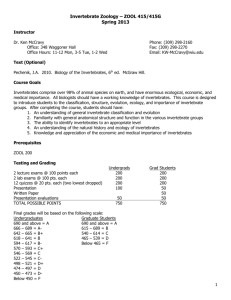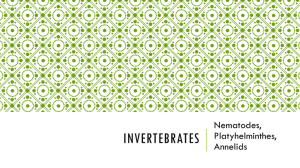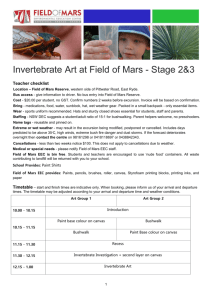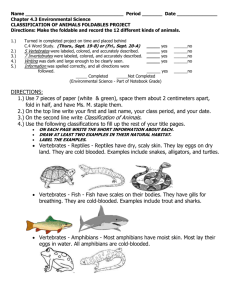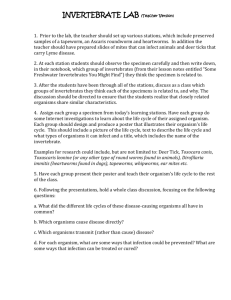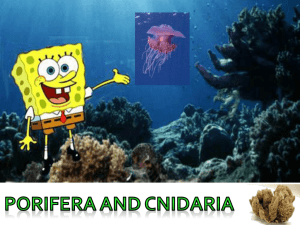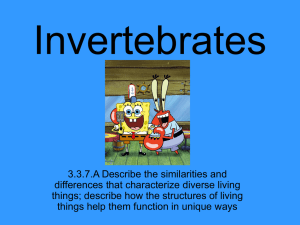biology 221 - invertebrate zoology i
advertisement
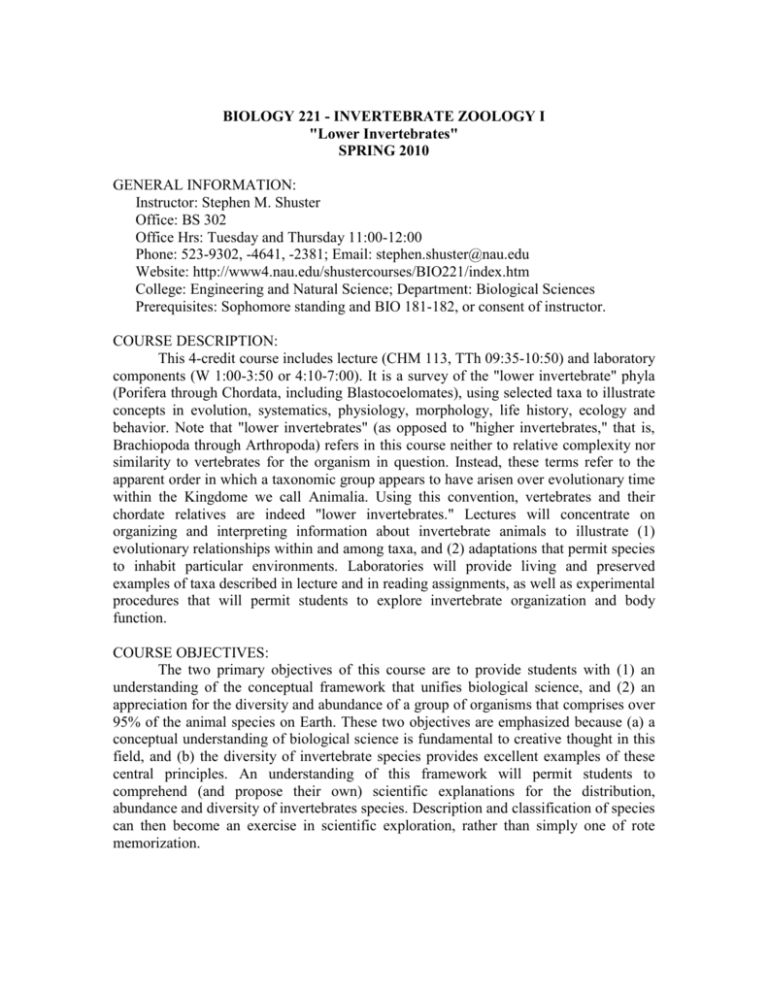
BIOLOGY 221 - INVERTEBRATE ZOOLOGY I "Lower Invertebrates" SPRING 2010 GENERAL INFORMATION: Instructor: Stephen M. Shuster Office: BS 302 Office Hrs: Tuesday and Thursday 11:00-12:00 Phone: 523-9302, -4641, -2381; Email: stephen.shuster@nau.edu Website: http://www4.nau.edu/shustercourses/BIO221/index.htm College: Engineering and Natural Science; Department: Biological Sciences Prerequisites: Sophomore standing and BIO 181-182, or consent of instructor. COURSE DESCRIPTION: This 4-credit course includes lecture (CHM 113, TTh 09:35-10:50) and laboratory components (W 1:00-3:50 or 4:10-7:00). It is a survey of the "lower invertebrate" phyla (Porifera through Chordata, including Blastocoelomates), using selected taxa to illustrate concepts in evolution, systematics, physiology, morphology, life history, ecology and behavior. Note that "lower invertebrates" (as opposed to "higher invertebrates," that is, Brachiopoda through Arthropoda) refers in this course neither to relative complexity nor similarity to vertebrates for the organism in question. Instead, these terms refer to the apparent order in which a taxonomic group appears to have arisen over evolutionary time within the Kingdome we call Animalia. Using this convention, vertebrates and their chordate relatives are indeed "lower invertebrates." Lectures will concentrate on organizing and interpreting information about invertebrate animals to illustrate (1) evolutionary relationships within and among taxa, and (2) adaptations that permit species to inhabit particular environments. Laboratories will provide living and preserved examples of taxa described in lecture and in reading assignments, as well as experimental procedures that will permit students to explore invertebrate organization and body function. COURSE OBJECTIVES: The two primary objectives of this course are to provide students with (1) an understanding of the conceptual framework that unifies biological science, and (2) an appreciation for the diversity and abundance of a group of organisms that comprises over 95% of the animal species on Earth. These two objectives are emphasized because (a) a conceptual understanding of biological science is fundamental to creative thought in this field, and (b) the diversity of invertebrate species provides excellent examples of these central principles. An understanding of this framework will permit students to comprehend (and propose their own) scientific explanations for the distribution, abundance and diversity of invertebrates species. Description and classification of species can then become an exercise in scientific exploration, rather than simply one of rote memorization. COURSE APPROACH: Class meetings (in CHM 113, TTh 09:35-10:50) will consist of lectures by the instructor, combined with audio-visual materials relating to current lecture topics. Students will be expected to prepare for lectures by reading from required texts and primary literature available on Reading in the library. The laboratory (in BS 146, W 1:003:50 or 4:10-7:00) will consist of displays of preserved or live invertebrates, hands-on inspection and dissection of preserved specimens, and field trips to local invertebrate habitats for instruction in observational and collection techniques. OFFICE HOURS Students are encouraged to make use of the instructor's and teaching assistant's office hours. The pace and volume of information introduced in this course makes it easy to get behind. If you even begin to feel overwhelmed, do not hesitate to get some help. TEXTBOOKS AND REQUIRED MATERIALS: 1. Brusca, R. C. and G. J. Brusca. 2003. Invertebrates, 2nd ed., Sinauer Assoc., N.Y. (required). 2. Reading readings (available on the class website, ; required). 3. Biology 221 Laboratory Manual, Spring 2010 (available at University Bookstore, requied) 4. Brusca, R. C. 1980. Common Intertidal Invertebrates of the Gulf of California. Univ. of Arizona Press. (optional; this book is currently out of print; you may special order a xerox copy from the UofA press for approximately $75). 5. BIO 221 Dissection kits (available in the NAU Bookstore; required, ask for them by name). 6. Laboratory notebook (loose leaf binder with white, unlined paper; required) EVALUATION: Examinations: The lecture portion of the course will require two lecture exams given during lecture periods, and a final exam at the end of the semester. Each lecture exam will be worth 100 points, the final exam is worth 200 points. You must take ALL of these exams (see Make-up below). Laboratory: The laboratory portion of the course will require two, one-hour practical exams and a final practical exam at the end of the semester. As with the lecture exams, you must take ALL of these exams. Each laboratory (excluding weeks with scheduled field trips; see syllabus) will begin with a 10-point quiz covering material from the previous as well as the present laboratory. Other credit given in laboratory will be explained in the laboratory manual. All lecture and laboratory exams will be comprehensive. You are responsible for all information presented in each part of this course. Total points for the course will be allocated as follows: Lecture exam points 400 Laboratory points 350 ____ 750 total points Grades will be assigned by one of two criteria. The most rigorous one is on a straight scale: 90% -100% of the total points = A; 80%-89% = B; 70%-79% = C; 60%-69% = D; 59% or lower = F. The less rigorous criterion will be based on the highest score received by a student in the class. That score will be considered "100%" and all lower scores will be adjusted to that scale. In cases in which students' total scores are extremely close to the next higher score (e.g., within 1.0 point), grades may be adjusted to account for enthusiastic class participation. All other adjustments will not be considered. Make-up Exams, Attendance and Cheating: Students will not be allowed to retake examinations under any circumstances. Students may take an exam in advance of the exam date if they know they will be absent. However, such arrangements must be made at least one week in advance of the scheduled exam. If an exam is missed, students must be able to document their reasons for missing the exam, and only extreme catastrophes will be considered as valid excuses. Only then will the exam be dropped from the student's total score. Car trouble is not an excuse because taxis are available in Flagstaff. All other missed exams will be counted as zero toward the student's total score. Regular attendance is strongly recommended given the amount of material introduced only in class. To excel in this class you will need to understand, integrate and apply information from lecture, laboratory and reading material. Academic honesty is the ONLY policy in this course. Evidence of plagiarism or cheating is justification for failure on an exam, expulsion from the course, and dismissal from the University, as stated in the Departmental policy for cheating and plagiarism (available in the Departmental Office). CHEATING IS A SERIOUS ACADEMIC OFFENSE! EXPECT NO LENIENCY WHATSOEVER! If you have any questions, see your instructor during office hours. Additional syllabus information for Northern Arizona University is available at: http://www3.nau.edu/biology/policies.cfm COURSE OUTLINE Invertebrate Zoology I – Spring 2010 ________________________________________________________________________ WK Date Lecture Topic Suggested Reading * Laboratory of the Week 1 01/12 Introduction, Biological Science Ch. 1, Reading #1 Laboratory techniques 01/14 Selection, Evolution 01/19 Phylogenetic Systematics Ch. 2, Reading #2 Phylogenetic Systematics 01/21 Phylogenetic Systematics 01/26 Animal Architecture Ch. 3, Reading #3 Porifera 01/28 Porifera I Ch. 6, 7 02/02 Porifera II Reading #4 02/04 Porifera III/Review 02/09 Exam I 02/11 Cnidaria I Ch. 8, Reading #5 02/16 Cnidaria II Reading #6 Cnidaria II 02/18 Cnidaria III 02/23 Cnidaria IV Reading #7 Field Trip to Mexico 02/25 Video: Secrets of the Ocean Realm Ch. 9 03/02 Ctenophora Ch. 4, Reading #8 03/04 Metazoan DevoEvo Ch. 24 03/09 Platyhelminthes I Ch. 10, Reading #9 03/11 Platyhelminthes II 2 3 4 5 6 7 8 9 Practical Exam I Cnidaria I Free-living Platyhelminthes Practical Exam II 10 03/15 – 3/19 11 03/23 Platyhelminthes III/Review 03/25 Exam II 03/30 Nemertea Ch. 11 04/01 Echinodermata I Ch. 22, Reading #10 04/06 Echinodermata II 04/08 Echinodermata III (KS) Reading #11 04/13 Echinodermata IV Ch. 23 Blastocoelomates 04/15 Other Deuterostomes 04/20 Blastocoelomates I Ch. 12; Reading #12 Laboratory Review 04/22 Blastocoelomates II 04/27 Blastocoelomates III 04/27 Course Overview 05/06 Final Exam: 7:30-9:30 12 13 14 15 16 17 Spring Break Parasitic Platyhelminthes Echinodermata I Echinodermata II Final Practical Exam * Chapters in Brusca and Brusca; Reserve Readings available on course website
